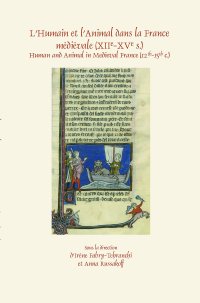
Ebook: L’humain et l’animal dans la France médiévale (XIIe–XVe siècles). Human and Animal in Medieval France (12th–15th c.)
Author: Irène Fabry-Tehranchi, Anna Russakoff
- Series: Faux Titre 397
- Year: 2014
- Publisher: Rodopi
- City: Amsterdam and New York
- Language: French, English
- pdf
Ce recueil explore les relations mouvantes entre hommes et animaux, aussi bien réels que fantastiques, dans la France médiévale, dans une perspective interdisciplinaire. Les auteurs examinent la façon dont le rapport humain-animal a été imaginé, défini et remodelé dans la pensée, la culture et la production artistique du Moyen Age. La distinction entre l’humain et l’animal, fondamentale dans le texte biblique et la philosophie antique, a été remise en question au cours du XIIe siècle. Ce phénomène transparaît dans la terminologie utilisée pour désigner les animaux, dans leur représentation dans les arts et la littérature, et dans l’évolution de textes fondamentaux comme le Physiologus ou les bestiaires. Les frontières entre le monde humain et animal, fondées sur des critères comme la maîtrise du langage, la capacité à rire ou la responsabilité légale, ont profondément évolué et été remises en cause entre le XIIe et le XVe siècle.
This is the first volume that explores the changing relationships between humans and animals, both real and fantastic, in medieval France, from a completely interdisciplinary perspective. The authors examine the way the human-animal rapport was imagined, defined and remodeled in thought, culture and artistic production. The distinction between human and animal, fundamental in the Bible and in Ancient philosophy, was challenged throughout the course of the 12th century. This phenomenon can be traced in changes in the terminology used to designate animals, in their representations in the arts and literature, and in the reworking of fundamental texts such as the Physiologus and the bestiaries. The borders between the human and the animal world, based on criteria such as linguistic ability, the capacity to laugh and even legal responsibility, evolved and were fundamentally reconsidered between the 12th and the 15th century.
This is the first volume that explores the changing relationships between humans and animals, both real and fantastic, in medieval France, from a completely interdisciplinary perspective. The authors examine the way the human-animal rapport was imagined, defined and remodeled in thought, culture and artistic production. The distinction between human and animal, fundamental in the Bible and in Ancient philosophy, was challenged throughout the course of the 12th century. This phenomenon can be traced in changes in the terminology used to designate animals, in their representations in the arts and literature, and in the reworking of fundamental texts such as the Physiologus and the bestiaries. The borders between the human and the animal world, based on criteria such as linguistic ability, the capacity to laugh and even legal responsibility, evolved and were fundamentally reconsidered between the 12th and the 15th century.
Download the book L’humain et l’animal dans la France médiévale (XIIe–XVe siècles). Human and Animal in Medieval France (12th–15th c.) for free or read online
Continue reading on any device:

Last viewed books
Related books
{related-news}
Comments (0)